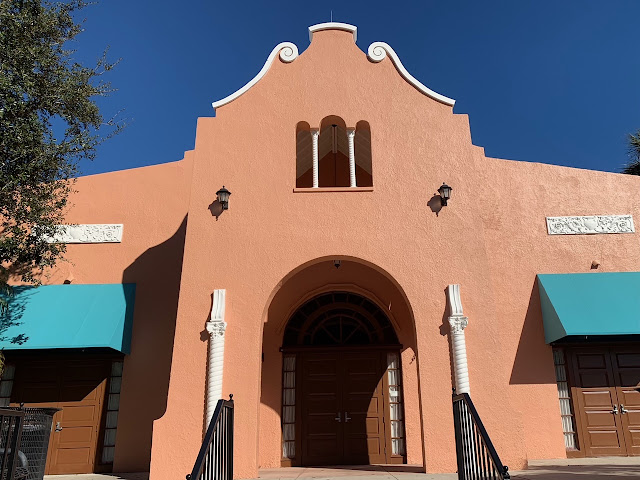If you happen along Marks Street just north of downtown Orlando, you may be surprised to see a long, low stucco building, painted in a distinctive shade of coral, that not only holds its own in the urban streetscape, but also looks somewhat familiar. The building is designed in the then-fashionable Spanish Revival or what is sometimes called Florida Spanish style. If you pause just long enough to study the main entry bay, you may hear echoes of a familiar theme: “Remember the Alamo!” The Alamo served as inspiration for this landmark structure.
This building is one of many schools designed by Orlando Architect Howard M. Reynolds, Sr. in the decade 1920-1930. Any one of them could be lifted up for conversation. This one is no longer a school, but rather a busy senior recreation complex, providing classes, lectures, and meeting spaces, and also serving as a lovely wedding reception venue. All of which it does with considerable grace and style. Keep in mind that such a design was considered modern, fresh, and cutting-edge in the 1920s. Here and there all over Orlando, architects were designing in this mode, and Howard Reynolds was among the best at doing so.
The Marks Street Senior Recreation Complex makes the most of a somewhat compact site. The building is set back from the street, and has a curved entry driveway, lawn, and lush landscaping to frame it. The stucco exterior shows a restrained use of mission type ornamentation, taking its cue from the Alamo, and other historic structures. The entry is so closely aligned to the Alamo, with its central doorway, curved geometric parapet, and careful symmetry, that one hardly need go to San Antonio to see the original. And yet it is not a slavish copy. Not at all. Indeed, upon closer inspection, the viewer will discover twisted columns, applied ornament, and other features that make the building poetic, if not romantic. It still works all these years later, but it is worth noting that the Orlando school board saw fit to commission architects like Reynolds to create schools that were not simply utilitarian, but endowed with an artistic flare that might serve to interest, inform, and inspire the students studying there. A worthy goal for a school building, then and now.
What else is of note at Marks Street? The arcades on each recessed courtyard are as simple in their geometry as could possibly be. Admirers of the work of Irving Gill, especially the La Jolla Women’s Club, will see affinities to it, in these arcades. Of course, they perform an essential Central Florida function, shielding the building and its visitors from the hot sun and torrential rain that are a predictable reality in our comer of the world. They also take the building in yet another direction that speaks a word of welcome, silently and eloquently.
Perhaps of greatest interest inside is the large multipurpose room that formerly served as the school’s assembly. The large French door type windows with their half circle transoms are another spare yet poetic element that take the room from box to what seems almost like an indoor garden room, an orangery, perhaps. This writer has attended wedding receptions in that room and found it to be admirably suited to the purpose. Indeed, brides take note, it is one of Orlando’s best-kept secrets in that regard. A century on, the building still works, inside as well as outside, all due to design choices that would appear to have had a modest impact on the original budget.
While other schools by Reynolds are of equal interest for their charm and their witty handling of stylistic elements (Cherokee School springs to mind), they are not as easily visited as the Marks’ Street Senior Recreation Complex, with its general public use for the community, open during regular business hours.
Howard W. Reynolds, Sr. has a long and notable history as a Central Florida architect. Reynolds was an American architect practicing in Orlando, Florida in the 1920s until the late 1940s. He designed gracefully proportioned, notable public buildings in the prevailing fashionable styles, including Mediterranean Revival, Colonial Revival, Spanish Colonial, Egyptian Revival, Art Deco and Art Moderne. Among Reynolds' best-known works are a number of educational buildings still in use as schools or community centers in Central Florida. The Marks Street Senior Recreation Complex is perhaps the most charming of them. Many of Reynolds' suave, stylish buildings have been designated as Orlando Historic Landmarks.
Reynolds' was among a small but active group of ten architectural firms listed in the Orlando phone directory in 1926, the others including: Frank L. Bodine, Fred E. Field, David Hyer, Murray S. King, George E. Krug, Ryan and Roberts (Ida Annah Ryan and Isabel Roberts) and Percy P. Turner. This group of architects felt it important to create a distinctive regional architecture, an effort which they described in the Florida journal The Florida Circle in 1924 as follows:
"Just as architects of old created styles to harmonize with their environment, so have the architects of Florida been creating, from native motifs, a style that is carefully adapted to the climatic conditions and surroundings of the state. This style has an individuality all its own and should have a fitting name to express its origins . . . The Florida Association of Architects will give a prize of $25.00 for the name selected."
Those who are an imaginative state of mind, might find themselves in the central driveway, or standing on the central stairs outside the main entrance, and thinking that this could be a fashionable resort hotel, as easily as a school or neighborhood center. The style is that sophisticated and appealing.





















No comments:
Post a Comment